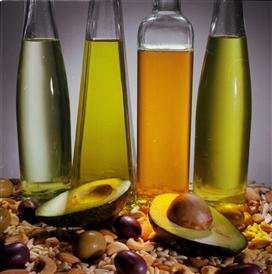
I had a few readers request I cover the topic of saturated fats as there have been a lot of mixed messages about these fats lately, so how do you know what to believe?! First off, lets cover the differences between the various types of fats:
Fat: One of three nutrients supplying energy to the body (the other two are protein and carbohydrate). Fat provides 9 calories per gram, more than twice the calories per gram provided by carbohydrate or protein.
Total Fat: includes saturated, monounsaturated, and polyunsaturated fats in food.
Saturated Fat: solid at room temperature and the main dietary cause of high cholesterol. Found mostly in animals and in some plants including: coconut, coconut oil, palm oil, pal kernel oil, and cocoa butter.
Trans Fatty Acid: a fat produced when liquid fat is turned into a solid fat through hydrogenation; raises LDL cholesterol and lowers HDL cholesterol.
Polyunsaturated Fat: liquid at room temperature and are from vegetable sources including corn, safflower, sunflower, soybean, cottonseed, and sesame seed oils. They are associated with lowering blood cholesterol levels when used in place of saturated fats in the diet. Can promote inflammation in high amounts.
Omega 3- Fatty Acid: type of heart-healthy polyunsaturated fat found in flaxseed oil, tree nuts, and especially fatty fish such as salmon, trout, sardines, and herring.
Monounsaturated Fat: liquid at room temperature and found in canola oil, olive oils, peanut oil, peanut butter, peanuts. Associated with lowering blood cholesterol.
Since saturated fat’s chemical composition makes it a solid fat, that’s exactly what it does inside our body…clogs our arteries causing increased risk for heart disease and stroke. “The American Heart Association recommends limiting the amount of saturated fats you eat to less than 7 percent of total daily calories. That means, for example, if you need about 2,000 calories a day, no more than 140 of them should come from saturated fats. That’s about 16 grams of saturated fats a day.” [http://www.heart.org/HEARTORG/GettingHealthy/FatsAndOils/Fats101/Saturated-Fats_UCM_301110_Article.jsp.] A diet low in saturated fats is also supported by the Academy of Nutrition and Dietetics. A good way to keep our heart healthy is to replace the solid or saturated fats with monounsaturated and/or polyunsaturated fats that are liquid, such as replacing the solid butter with olive oil, canola oil, etc. You can also increase your consumption of fish and nuts as they have higher contents of these healthy fats as well.
Two common confusing parts of this concept are beef consumption and coconut oil.
BEEF: Did you know that beef is 20% leaner than it was about 15 years ago? There are at least 29 cuts of lean beef which means they meet the government guidelines for lean, meaning each cut has less than 10g of total fat, less than 4.5 g of saturated fat, and less than 95mg of cholesterol (in a 3 oz serving). Beef has often gotten a bad rap, but in reality it can be part of a healthy diet when choosing the lean cuts and healthy cooking methodss. Here are some tips for you to make beef a part of your heart healthy meals:
- Look for key words such as “round” or “loin” …these are typically leaner cuts
- Choose 90% or greater lean beef. This means in a 3oz serving there is less than 5g of fat in it.
- Use healthy cooking methods such as grilling, broiling, baking, roasting, or braising. The less tender cuts can be marinated in a tenderizing marinade such as salsa or light Italian dressing.
- Trim the fat! Trimming the fat before cooking will help eliminate some of the fat from the cut.
- Cook with fresh ingredients such as lemon juice, peppers, onions, garlic, and herbs instead of adding extra fat to the cut.
- Practice portion control. Select the 3-5 oz serving over the 10oz.
COCONUT OIL: Coconut oil has gotten more popular over the last few years. Many are choosing it over the olive oil now and it’s somewhat become a craze. Coconut oil is a saturated fat and when looking at it, you can see that as it’s solid. The big debate about it, is that the primary fat of coconut oil is “lauric” acid (a type of fatty acid) that is absorbed by the body differently than the other common saturated fat, stearic acid. The make up of coconut oil is a medium chain triglyceride (type of chemical structure) and the MCTs tend to increase HDL (good) cholesterol better than other saturated fats such ad lard and butter. Many unsaturated fats such as olive oil decrease LDL (bad) cholesterol, improve total cholesterol/HDL ratio, and can also increase HDL cholesterol as well. As you can see this is a very complex concept and subject that involves food science, chemistry, etc. There are compelling arguments on both sides, which makes it very confusing for the consumer. Overall, coconut oil can play a role in raising HDL and provides flavorful cooking, but it does have a significant amount of calories and does promote increased total cholesterol levels…especially when compared to unsaturated fats such as olive oil, canola oil, peanut oil, avocados, nuts, and salmon. Since it is still a saturated fat, I recommend to limit the consumption and practice moderation with it.
Overall, saturated fats are still recommended to be limited in our diets due to their link to heart disease, but there are some interesting concepts to learn and understand about this topic. The good fats, mono- and poly-unsaturated fats should be included in our diets as they promote heart health, so some fat is actually a good thing. It’s hard to cover this type of topic in a blog post because it is so complex, so if you want to learn more about it and/or discuss it further with me, feel free to contact me anytime!
-Kelsey

